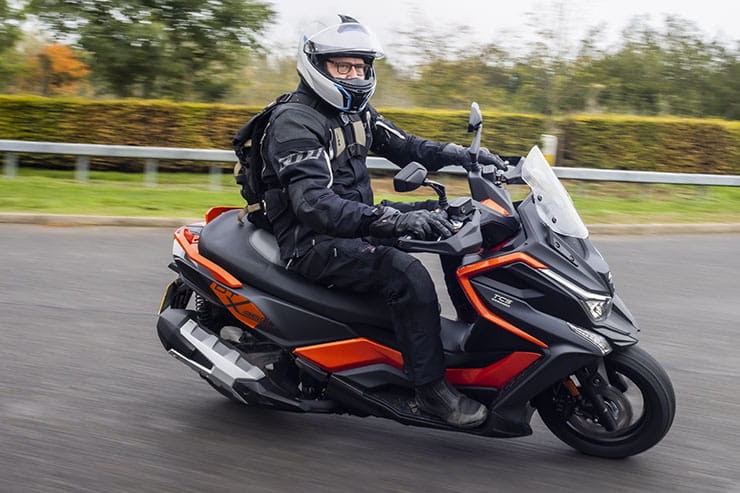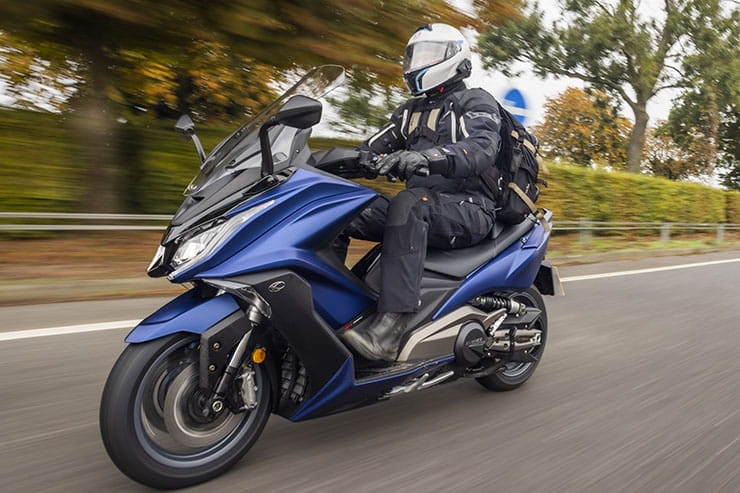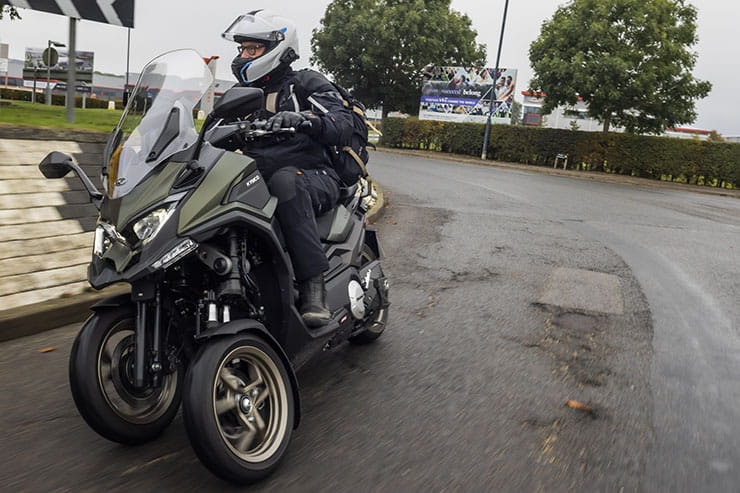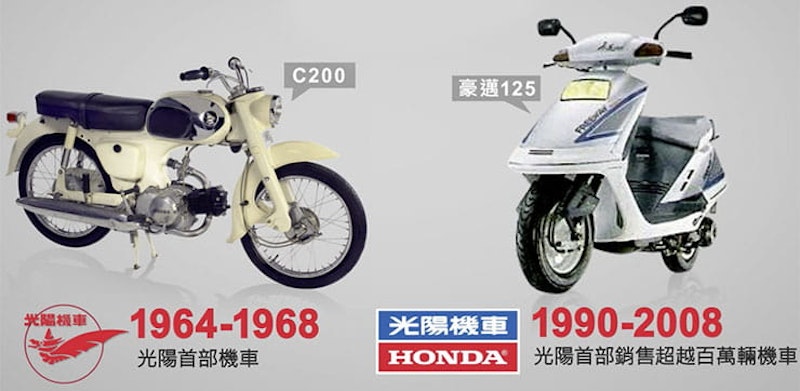Kymco AK550 & DTX 360 (2022) - Review + more | Who is Kymco?
By John Milbank
Consumer Editor of Bennetts BikeSocial
17.10.2022
Have you ever heard of Kymco? Those in the industry will be well aware of its collaboration with Kawasaki, but there’s a rich history with some of the biggest Japanese and European brands that put this Taiwanese company in a strong position.
I spent a day talking to the bosses and road-testing five of its machines to find out why Kymco hopes, through a solid dealer network, to become a major player in the UK market…
Who is Kymco?
Kymco, known for its scooters, motorcycles, ATVs and mobility scooters, is an abbreviation of Kwang Yang Motor Company, headquartered in Taiwan. It was founded in 1964 by Mr Kwang-Su, Ko and started out as a manufacturing facility for Honda Japan.
Over the next 20 years, Honda became a significant shareholder of Kymco, and the first bike launched as a partnership between Honda and Kymco was the C200 in 1964, while the Hao Mai 125 – built from 1990 to 2008 – was the first to sell over a million units.
It wasn’t until 1992 that Kymco started selling bikes developed independently from Honda under its own brand.
In 2003, Kymco separated from Honda by buying back the Japanese company’s shares in order to focus on its own brands, with revenue in 2020 reaching $1.48 billion. The offices, R&D, testing and manufacturing facilities in Kaohsiung now cover a total of about 47 acres (so roughly 24 football pitches), with subsidiaries around the world including Changzhou Kawasaki and Kwang Yang Engine Company Ltd, which were set up in 2009 as a 50/50 venture between Kawasaki and Kwang Yang holdings to produce ‘general purpose gasoline engines’.
It’s also an investor in several strategic partners, including Taiwain Keihin Carburettor for fuel injection systems and Kaifa for shock absorbers, and it owns – among others – Tai Chi Co. Ltd, the sole distributor of Kawasaki motorcycles in Taiwan.
Kawasaki, BMW and Textron (a huge company that covers Bell helicopters and Cessna, but in this case it was the ATV arm that benefitted) have all had strategic partnerships with Kymco.
The Kawasaki-branded J300 and J125 scooters were built by Kymco, as were several Kawasaki ATVs. The Taiwanese company also supplied the engines for the BMW G450X, C600 Sport and C650GT, as well as the 650cc range-extending engine used in the BMW i3 car…
What does Kymco’s future look like?
I spoke to the Kymco UK Team to find out more about the brand. In Taiwan, Kymco is the market leader for scooters, holding 33.9% of the market and well-ahead of Yamaha sitting in second place, while the Agility City 125 is the biggest-selling scooter in Spain and Italy.
“We’re a lot bigger than many people realise,” Mark Hermolle, managing director of Kymco UK told me. “But the brand is stronger globally than it is here at the moment, which is why we want to raise awareness. We want to portray our build quality. I say to people that many believe some bikes to be ‘Japanese quality’, but it’s often Kymco quality, branded as Japanese. I’m proud to think we’ve partnered with some top-flight companies, and it’s our quality they’ve been promoting.
“We don’t want to be perceived as cheap and cheerful; we stand behind our products with quality, service, support and a strong dealer network. We want to be seen to be more of a premium brand.
“We have full UK parts backup, holding what we hope will be everything we need for our dealers.”
“We’d like to have no less than 85 high-calibre dealers,” added sales manager Neil Keeble, “but it’s more about the quality of the dealer, rather than just being available in every town. We want to work in partnership with the dealers, not acting as a dictatorship to them.”
So what can we expect to see over the coming months and years? There was talk of an ER6-based Kymco back in 2016, but while there is a K-Rider 400 in Asia, the 650 never came to market. “Kymco is focussing on electric motorcycles now” said Jeff Wu, vice chairman. “We invested $100 million dollars into Livewire,” added Mark. “We’re developing the Ionex range with the Super 7 and the Super 9 in Asia, but in the UK we’re starting with the I-One [a £3,999 electric scooter that weighs 97kg when fitted with one of the 10kg removable batteries. It takes eight hours to charge, and has a claimed range of 37 miles at 18mph, and a max speed of 28mph.]
“RevoNEX is still very much in development, with a six-speed gearbox and slipper clutch. Should that become a mass-produced product, it’ll be key to the UK.
“We’re moving to green performance, but with the spirited ride.”
On the road with Kymco
We only had time for some relatively short road-tests of a handful of Kymcos, which all come with two-year warranties, and while it can be hard for new riders – especially young ones – to get test rides of any bike due to difficulties for the dealers in getting insurance, Kymco UK promises that it’s doing what it can to make the machines available across its dealer network.
It's also worth mentioning this Kymco UK is working out a deal with Datatool for additional security, including the option of trackers, which it promises will be hidden in a variety of locations by dealers, rather than being stuck all in the same place. The only disappointment with the current range is that none of them feature electronic immobilisers. Fitting something like the Datatool Evo would be worthwhile, and it’s not difficult.
I had a day and a half to try a selection of Kymco’s range, so while these won’t be up to the usual detailed standard of a BikeSocial review, it was a chance to better get to know the brand…
Kymco AK550 mini review
Billed as a ‘sport tourer’, it’s impossible not to compare the Kymco AK550 to the Yamaha TMAX, which costs £12,700.
The AK550 is an aluminium-framed maxi-scooter that performs and handles great. It’s not going to ‘beat’ what many would call a ‘proper’ motorcycle, but on the road – unless you’re trying to prove a point – it’s plenty fast enough, the twist-and-go transmission pulling quickly and smoothly away from lights or out of corners.
All small-wheeled machines like this feel more harsh over bumps than a motorcycle with larger rims, but the AK’s suspension does a good job.
It’s also got great brakes, the radially-mounted Brembos up front pulling it up well, and when used in conjunction with the left lever-operated rear brake, provide plenty of stopping power, if not as sharp as some of the systems on the latest motorcycles
There are plenty of extras like tyre pressure monitoring and heated grips as standard, and this is truly a great bike to ride, but it’s little niggles that can leave you thinking ‘if only they’d done that differently’…
The dash has Kymco’s Noodoe system, which links to your smartphone to provide turn-based navigation, as well as weather reports and the ability to put your own pictures on the screen. Navigating it though is made a little awkward thanks to a clunky button layout that sees a toggle switch change what the selection buttons do.
There are other user-interface grumbles, like coloured bars that tell you whether you’re in the normal or rain riding modes (rather than using words), the inability to change riding modes while you’re riding, or the fact that it’s easy to knock the hazard lights on, yet not notice them flashing on the dash. The indicators make a loud and useful relay click sound, but the hazards are silent.
The dash is set a bit too horizontally, making it difficult to read in some sunny conditions, and you can’t see into the two awkwardly-sized cubby holes on the front when you’re sat on the bike.
The AK550 has keyless ignition, though the power switch is a bit of a faff to use, and it’s a shame we weren’t able to get any of the full-face lids we tried to fit under the seat. Maybe if you have a smaller shell size it’ll go.
Which sounds like a lot of reasons not to buy the Kymco AK550, but look past the niggles and while it might feel quite long, it’s very easy to carve through tight traffic, has a good turning circle, plenty of foot-room, reasonable protection from the screen (even if you do have to unbolt it to adjust its position), and it is, quite simply, great fun to ride.
Whether you’re willing to pay £3,000 to avoid these grumbles if something only you can decide, but the overall build quality of the AK is very impressive. If you’re in the market for a maxi-scooter, this should be on your shortlist, and I’m interested to see what the next generation brings, which we’re already told will feature cornering ABS.
Kymco DTX 360 mini review
Knobbly tyres do not an off-roader make, but the Kymco DTX 360, which is available in both 320cc and 125cc versions), is likely to appeal to those looking at the £11,099 Honda X-ADV.
Clearly, the ground-clearance on the Kymco can’t match the Honda, and they are actually quite different machines, but the DTX 360 has a quality feel and looks the part, even if it’s only ever going to see gentle green lanes and fire tracks.
The 320cc single-cylinder motor I rode shoves the DTX away from lights with surprising vigour, topping out at high motorway speeds. It’s also a very easy bike to throw around in corners and has a good turning circle; the low centre of gravity of machines like this making them really easy to thread through traffic.
The brakes aren’t the radial Brembos of the AK, but they’re more than good enough, and while you still have the slightly harsh ride that small wheels inevitably bring, this thing handles well.
It’s a shame a full-face lid won’t fit under the seat and that the screen’s not adjustable (though I found it fine at 5’10”). And it’s just weird that it has traction control that defaults to off every time you start it! Still, you don’t really need it.
There’s a USB-outlet under a cover on the bars, and the front cubby box easily swallows my phone. It’s even got keyless ignition, and there’s a decent amount of room to move your feet about, including vertical footboards.
Overall, the Kymco DTX 360 - 320 is a great scooter, and while I wish I could fit a lid in under the seat, I’ve got nothing else to really complain about. In fact, I’d go so far as to say that I want one!
Kymco CV3 mini review
Like the Peugeot Metropolis and Piaggio MP3, the new Kymco CV3 can be ridden on a car licence, as long as you got it before 19 January 2013. I wouldn’t recommend it though – it’s well worth taking a day’s CBT first in order to get a feel for how it feels to ride something with two wheels.
Yes, this the CV3 has three wheels, but besides the fact that it can be locked upright when stationary, it handles pretty much like a large two-wheeled scooter, so you need to understand the principles of leaning over, and how bikes turn at speed.
First impressions of the Kymco CV3 are that it’s very well finished, with decent plastics and good-looking (and feeling) switchgear. The styling’s great, although of course the two wheels up front mean it won’t be to everyone’s taste.
Having tha pair of wheels doesn’t mean the contact patch is greater; it’s the extra weight up the front compared to a ‘normal’ scooter that increases the amount of rubber on the road. You also effectively have grip redundancy built in; if you hit a slippy manhole cover on a traditional scooter, the front wheel could lose all its traction. However, hit it with one of the two wheels on the front of this, and you’ll still have grip. If you want to get your head around it, check out this video where we tried to crash a three-wheeled Yamaha Niken.
Clambering onto the CV3 is a little harder than you might expect – it doesn’t help that it’s upright, rather than on a stand, but at 5’10”, I found it a bit of a stretch to sling my 32” inside leg over. Once on, I could get my feet down okay, but the seat height, and the width of the bike, make it feel quite large.
Turn it on (it’s keyless ignition), release the handbrake on the left bar then press the button to unlock the front wheels and you’re suddenly reminded of the weight of this machine, and the fact that it can appear a little top-heavy.
Once on the go, naturally that weight disappears, but experienced riders of two-wheeled machines will likely feel it’s slightly sluggish to turn, requiring just that little more effort to tip in, and not having the natural agility that a more narrow scooter gives you.
It’s a learning experience though, and you soon get used to the feel of the CV3, though I was surprised at how easily the underside touched down during a spirited run around a small roundabout.
The 550cc motor won’t win many traffic-light drag races in this twist-and-go form, or with this weight, but the Kymco reaches 90mph easily. In the short road test I had, the unadjustable-without-a-spanner screen seemed fine; it’s not the quietest, but I found no annoying buffeting or vibration.
There’s cruise control as standard, and when it comes to stopping, the front’s equipped with a pair of Kymco-branded two-piston calipers. While they’ll put it to a stop, they work better in conjunction with the single-piston rear, operated by the lever on the left bar. There’s also a foot brake, which operates both the front and rear, but it’s got quite a digital feel, seeming to do very little until you push hard enough, then the anchors really drop.
One of the brilliant things about scooters is their practicality, so I was a little disappointed that I couldn’t fit my flip-front AGV Tour Modular under the seat. Still, the dash is an easy to read TFT, with some neat features from Kymco’s own ‘Noodoe’ navigation system, as seen on the AK550.
As congestion charges become more prevalent, it’s easy to see how car drivers could be tempted towards something like this, especially if it means they don’t need to get a motorcycle licence. Three-wheelers aren’t going to suit everyone, and while they handle similarly, this doesn’t offer quite the experience, nimble handling or sense of excitement of two wheels. But there are genuine benefits to machines like the Kymco CV3, and if it means more people getting out of cars, then this deserves to be a success.
Kymco VSR 125 mini review
It’s easy for journalists to get over-excited about little 125s, as when a bunch of us get together on small-capacity bikes it’s a great skill leveller. And everyone wants to be at the front. Laying over the tank and looking for every overtake opportunity can bring back memories of Fizzies and RDs for many, but the reality is that a 125 ridden on your own to work and back every day can be far less fun than ‘racing’ your mates.
The Kymco VSR 125 doesn’t have the premium feel of the larger-capacity machines, and it’s faced with some very strong competition to challenge it on price and performance. If anything, the two 125 Kymcos we rode felt somewhat out of place compared to the larger-capacity machines and their impressive build-quality.
The Kymco VSR 125 has a hard seat, but the suspension is good enough for spirited back-road riding. The gearbox is okay, but can feel a little rough around the edges at times, mine once refusing to go beyond third (though I was trying to out-drag Dan from Motorcycle News at the time, and it quickly cleared itself).
The brakes are linked, so stamp on the rear and the front will bite too. It’s a legal alternative to ABS, but it’s not as good as a half-decent anti-lock system, and it’s not as much fun because you can’t do childish skids.
One more grumble is that the pegs aren’t sprung, so if you knock one upright you end up fishing around with your feet to find it. Losing a pound or so profit here would have been worthwhile. But the good news is that the engine’s surprisingly willing. While we didn’t get a chance to run a GPS to check the speedos, glancing at the lead rider’s Africa Twin dash, the bike I was on seemed pretty realistic, and it hit an indicated 60mph fairly easily. I saw 70mph too at one point.
The Kymco VSR 125 serves a purpose well in that it’s a relatively cheap machine for a new rider, or someone looking for a budget commuter. There are lower-priced machines from Chinese rivals, but it’s too early to say how well the VSR 125 will stand up to several winters compared to others, or whether Kymco UK’s Bridgend parts and support will be an advantage.
Kymco Agility City+ 125 mini review
Like the VSR 125, the Kymco Agility City+ doesn’t have the more premium build quality that the company’s experience with the likes of Honda and Kawasaki has shown it capable of. It’s faced with some tough competition from the Chinese, and again, it’s too early to say if it’s earned the higher price tag.
The Agility City+ has what you need in under-seat storage (if not big enough for a full-face lid), a small lockable cubby in the front, and the ever-essential shopping hook.
The brakes are linked (though you wouldn’t know it – the back locks easily without seeming to affect the front). And while the suspension feels rudimentary, it’s okay.
The side-stand’s sprung, so as soon as you lift the scooter it flicks away. That no doubt saves money on a cut-out switch, but it’ll probably cost a few people in fairing repairs.
The Kymco Agility City+ goes okay; it can struggle much above 50mph at times, but it’s a no-frills run-around that could make all the difference to someone needing to get to work in a busy – and probably congestion-charged – city.
It’s cheaper than many rail season tickets too. And a lot more reliable.
Should you buy a Kymco? Mini review verdict
The time I got on these bikes was little more than a short road-test, but it did give a pretty good impression of the machines.
The maxi-scooters had what appeared to be very good build-quality, and as there happened to be a previous-generation AK550 that was being used by one of the support riders, it was a chance to see how they weather. Besides some paint flaking on the brake reservoir, there were no significant signs of corrosion.
Kymco does appear to be very much in the process of refining its products, and the mix of bikes we rode were in various stages of their lifecycle. It was noticeable that there was little consistency in the switchgear layouts used, and that the two 125s felt a lot cheaper in their construction, but then again they are budget machines appealing to a different audience than would be likely to buy the AK, the DTX or the CV3.
The DTX 360 was my favourite bike, feeling the most advanced in its development and offering pretty good value for money. Kymco has a solid history, and while it might not be a household name right now, it’s worked with some of the biggest brands to prove it has the manufacturing capabilities needed to be a real challenger.
With an ever-growing dealer network and the promise of solid UK-based warranty and parts support, Kymco is undoubtedly one to watch…



